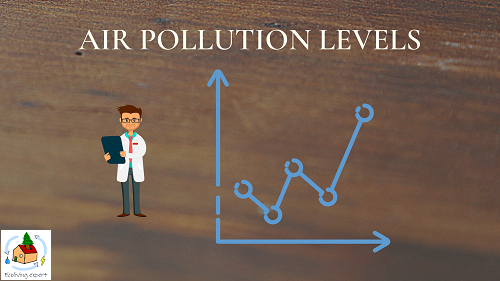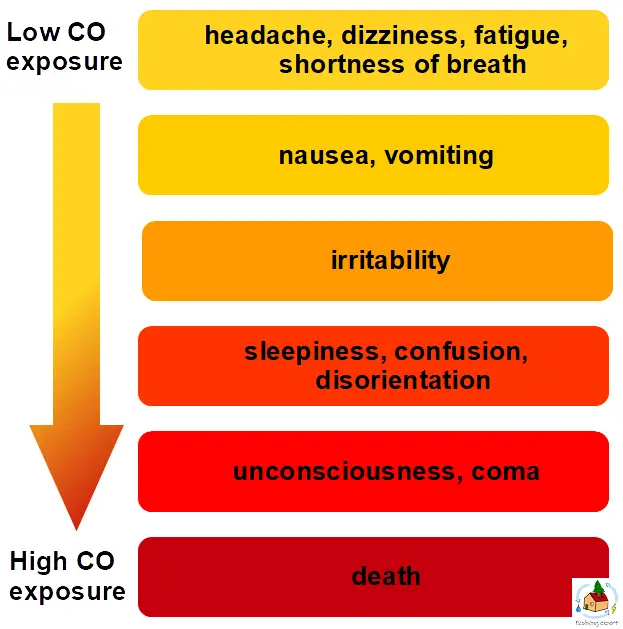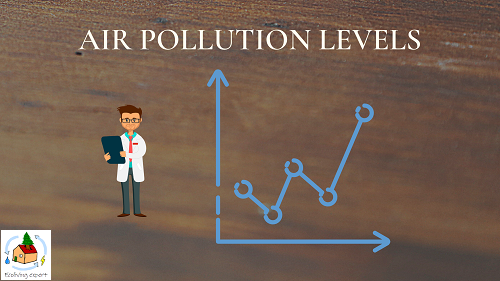There are many different air pollutants, and how dangerous they are to your health differs per compound. Additionally, your level of exposure to these compounds determines how they affect your health. For some compounds, low concentrations can already be quite harmful. Other compounds pose low health risks even in very high concentrations.
Let’s have a look at what the most common air pollutants are indoors and outdoors. And at what concentrations you need to take action to protect your health.
Above these levels, air pollution becomes dangerous:
- Fine dust
- PM 2.5: 10 µg/m3 average per year
- PM 10: 20 µg/m3 average per year
- Carbon monoxide (CO): 10 µg/m3 maximum daily 8-hour mean
- CO2 (carbon dioxide): 1000-2000 ppm
- Radon gas: 4.0 pCi/L
- VOCs, formaldehyde: 0.4 ppm
- Mold: no legislation, avoid mold growth
At the end of this article, you will find a detailed overview table of all the common pollutants and the concentrations at which they become dangerous to our health.
Common air pollutants
First, let’s have a look at which air pollutants are commonly found indoors and outdoors.
The most common air pollutants are:
- fine dust particles (indoors and outdoors)
- carbon monoxide (CO) (indoors)
- CO2 (carbon dioxide) (indoors)
- radon gas (indoors)
- volatile organic compounds (VOCs) (indoors)
- formaldehyde (indoors)
- mold (indoors)
Since we spend about 90% of our time indoors, we are mostly exposed to indoor air pollutants. On top of that, indoor air is easily trapped, and without proper ventilation, indoor air pollution levels can rise quickly.

Harmful levels of indoor air pollutants
Fine dust
Fine dust is a collective name for all kinds of particles that are present in the air. Common fine dust particles are dust and soot. These particles are commonly found indoors and outdoors.
Fine dust is often called particulate matter (PM). Since their size influences how deep they can enter our lungs, fine dust is separated in two sizes, PM 10 and PM 2.5. PM 2.5 includes particles smaller than 2.5 µm (micro meters) and PM 10 includes particles smaller than 10 µm (and larger than 2.5 µm). PM 2.5 can reach deeper into the lungs and cause more harm.
The following table shows the levels that are not to be exceeded over a set timeframe (averaging period). Based on the World Health Organisation guidelines on particulate matter (source: WHO 2018). There are no safe levels of particulate matter.
| Pollutant | Concentration | Averaging period |
|---|---|---|
| PM 2.5 | 25 µg/m3 | 24 hours |
| PM 2.5 | 10 µg/m3 | 1 year |
| PM 10 | 50 µg/m3 | 24 hours |
| PM 10 | 20 µg/m3 | 1 year |
What is fine dust exactly?
Fine dust particles are really small dust particles. They are especially harmful since they can more easily enter your lungs compared to regular dust. Fine dust is found all over the house.
Indoor fine dust has many causes, including cooking, lighting candles, and outdoor air (coming from car exhausts).
Health effects of fine dust
Inhaling fine dust particles can lead to several health issues such as:
- irritation of airways
- decreased lung function
- an increase in respiratory problems and asthma
- premature death in people with lung or heart disease
Unfortunately, there are no safe levels of fine dust. The table above shows European legislation levels which are based on acceptable levels for both our health and the emittance of fine dust.
It is healthiest to not inhale any fine dust. However, this is not possible as even naturally clean air contains some amount of fine dust. For example, the air always contains some amount of particles coming from the soil, plants, or salt from the sea.
Carbon monoxide (CO)
Carbon monoxide (CO) is a colorless odorless gas that is formed by incomplete burning of carbon-based fuels. Incomplete burning happens in all fires but also in (efficient) appliances.
The most common sources of carbon monoxide are central heating systems and kerosene and gas space heaters such as geysers and boilers. Other sources of CO are gas stoves and the fireplace. Additionally, CO can enter the house via leaking chimneys and vents. Tobacco smoke is another source of carbon monoxide.
The following table shows the levels that are not to be exceeded over a set timeframe (averaging period). Based on European legislation (source).
| Pollutant | Concentration | Averaging period |
|---|---|---|
| Carbon monoxide (CO) | 10 mg/m3 | Maximum daily 8-hour mean |
Health effects of carbon monoxide
Carbon monoxide, when inhaled, quickly enters the bloodstream and reduces the blood’s ability to carry oxygen. This results in oxygen deprivation which can be deadly in high doses and causes all kinds of health effects. The following figure shows the health effects of CO exposure related to an increase of CO exposure. (source: World Health Organisation)

CO2 (carbon dioxide)
Carbon dioxide (CO2) is an odorless, colorless gas that only causes health issues in relatively high concentrations. You can read all about CO2 in our article: What are healthy indoor CO2 levels?
The following table covers all the levels of CO2 and their effects on human health. The levels are given in parts per million (ppm), this is an indication of the amount of CO2 particles in the air per 1 million air particles (there are many different particles in the air including oxygen (21%), nitrogen (78%) and CO2 (0.04%).
| Levels of CO2 (ppm) | Value | Negative health effects |
|---|---|---|
| 250 – 400 | Normal (background) outdoor values | No negative health effects |
| 400 – 1000 | Typical occupied space with ventilation | No negative health effects |
| 1000 – 2000 | Exceptionally high | Complaints of drowsiness and poor air |
| 2000 – 5000 | Exceptionally high | Headaches, sleepiness, poor concentration, loss of attention, increased heart rate and slight nausea may occur. Complaints about stagnant, stale, and stuffy air. |
| 5000 | Maximum 8-hour exposure limit | This indicates conditions where other harmful gases could also be present. Toxicity and oxygen deprivation can occur. |
| 40000 | Oxygen deprivation level | Oxygen deprivation and CO2 toxicity |
| 315 – 415 | Global rise since 1960 | Global warming* |
*Global warming does not have direct negative health effects since the CO2 levels are still in the normal range. However, CO2 traps heat inside the atmosphere, and a rise in CO2, therefore, means a rise in global temperatures, causing climate change. This causes sea-level rise due to melting ice caps, desertification, extreme weather events, etc.
Radon gas
Radon is a radioactive gas that originates from the soil where the natural elements uranium and thorium are present. It arises from the natural decay of these compounds.
As a colorless, odorless, and tasteless gas, radon is quite difficult to detect.
In the United States, radon gas is the second leading cause of lung cancer. Radon is prevalent in many parts of the world. You can read all about radon in our article: What is radon? (origin, health risk, and preventive measures).
There is no safe level of radon. However, the average concentration of radon in outdoor air is 0.4 pCi/L (picocuries per liter, and yes picocuries is the actual unit).
The EPA recommends taking action in your home when levels rise above 4.0 pCi/L. That is ten times the average outdoor level. If you have levels between 2 and 4 pCi/L, the EPA recommends to at least consider taking measures.
Volatile organic compounds (VOCs)
Volatile organic compounds are mostly human-made chemicals that are emitted as a gas from solids or liquid. There are very many different VOCs and their effects can range from highly toxic to no known negative health effects. (source)
The most common sources of VOCs in are:
- paint
- cleaning products
- deodorizers
- dry cleaning fluids
Since there are many volatile organic compounds, there is not one concentration limit set for VOCs. However, there are some targets set for formaldehyde, a common VOC that is known to cause cancer.
Formaldehyde
Technically formaldehyde is a common VOC. However, I want to mention it separately because it is stated by the Environmental Protection Agency (EPA) to potentially cause cancer
The following table shows the targets set by the OSHA (Occupational Safety and Health Administration) in the US for a safe work environment as well as formaldehyde levels at home.
| Pollutant | Concentration | Averaging period |
|---|---|---|
| Formaldehyde | 0.75 ppm (at work) | 8 hours |
| Formaldehyde | 0.4 ppm (at home) | not applicable |
Formaldehyde is a colorless, pungent-smelling gas that can be released from insulation and building materials such as composite wood. Other sources are:
- cleaning products, fabric softeners and conditioners
- carpeting
- glues and resins
- tobacco smoke
- a type of insulation called urea-formaldehyde insulating foam (UFFI)
Mold growth
The spores of molds are always present in the air in very small quantities. They normally do not pose any health hazards. However, when mold spores land in a spot that is humid and warm, they can start to grow and produce very high quantities of spores. This can lead to various health effects and can damage wood and fixtures.
There are no international guidelines on what amount of mold in the air is considered safe of unsafe. This is the case becasue health hazards of molds depends highly on the type of mold and the person who is inhaling the mold spores.
It is recommended to avoid mold growth as much as possible. Additionally, keep in mind that mold mostly affects the respiratory system. Therefore, if you already have respiratory issues, you will need to take extra care of mold. Additionally, the elderly, as well as babies and young children, are most at risk.
Overview table
The following table shows per pollutant if there are safe levels in the air, at what concentration these compounds rise above current legislation limits, and over what time period this level is allowed.
| Pollutant | Safe levels? | Concentration | Averaging period |
|---|---|---|---|
| Fine dust PM 2.5 | No | 25 µg/m3 | 24 hours |
| Fine dust PM 2.5 | No | 10 µg/m3 | 1 year |
| Fine dust PM 10 | No | 50 µg/m3 | 24 hours |
| Fine dust PM 10 | No | 20 µg/m3 | 1 year |
| Carbon monoxide (CO) | Yes, <10 µg/m3 | 10 µg/m3 | Maximum daily 8-hour mean |
| CO2 (carbon dioxide) | Yes, <1000 ppm | 1000 – 2000 ppm | n.a. |
| Radon gas | No | 4.0 pCi/L | n.a. |
| VOCs, formaldehyde | No | 0.4 ppm | n.a. |
| Mold | Unknown | As low as possible is safest | Unknown |
Compared to outdoor air pollution, indoor air pollution is the most dangerous,
Indoor air pollution is often between 2 and 5 times worse than outdoor air. It can even be 100 times worse. According to the US Environmental Protection Agency (EPA).
Even though indoor air is more dangerous than outdoor air. Most of the worlds focus has always been on outdoor air pollution such as smog (dirty city air, a combination of smoke+fog) and particulate matter from traffic exhaust.
In recent years, more attention is focussed on indoor air quality, and for good reason. We spend much more time indoors than outdoors (up to 90%!), and indoor air pollution is often worse than outdoors.
How does air pollution affect our health?
The health risk of air pollutants is dependent on several factors. These include:
- the type of compound,
- the amount present in your air,
- your exposure to them, and
- your overall health.
The immediate effects of bad indoor air
Sometimes exposure to air pollutants can lead to immediate health effects. According to the US Environmental Protection Agency, these effects can be:
- irritation of the eyes, nose, or throat
- headaches
- dizziness
- fatigue
- increased symptoms of asthma or any other illness
Long-term health effects
The EPA states that long-term health effects of indoor air pollutants may show up years after exposure or after long or repeated periods of exposure. Possible long-term adverse health effects include:
- respiratory disease
- heart disease
- cancer
On top of that, repeated exposure to hazardous substances can cause sensitization.
Want to know more?
If you would like to know all about indoor air pollution, please read my article: The complete indoor air quality guide for your home.
Do you want to know what causes your poor indoor air? This is what causes your poor indoor air quality.
Want to check your own indoor air quality? please read: How to check the air quality in your home without measuring instruments.


